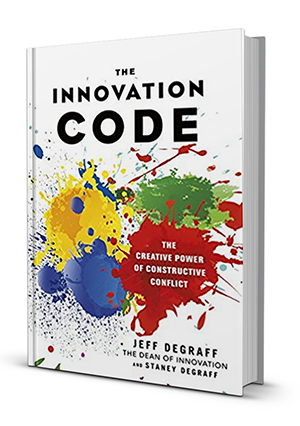Often, I’ve noticed, when I talk to someone about the need to innovate, that person will respond by telling me how much he or she is doing already.
These days we make productivity something like a religion. We believe that if we are productive enough, organized enough, task-focused enough, that this will save us from the fact that our lives are overcommitted.
I think of Jon, a manager who worked for a corporate client of mine. I was helping his company develop new approaches to efficiency, but he wasn’t using any of them. He wasn’t even giving them a try. In fact, he was running his team exactly the way he had run it three years earlier.
When I asked Jon if he had considered trying some of the company’s new efficiencies with his team, he turned his computer screen around so I could see it and brought up his work schedule. “Look at this calendar!” he cried. “I’m working seventy hour weeks. You won’t find a more efficient employee in this entire company!”
I didn’t disagree. He was working very long hours and his scheduling was highly efficient. I admired his drive and his focus, and I told him so. But I also told him that from the point of view of innovation, his efficiency was not a plus. It was evident that he was getting it wrong.
Perhaps the most important of these rules is the 80-20 rule, also known as the Pareto Principle. It states that 80% of the results we’re trying to achieve come from only 20% of the causes. It was first inspired by the observation that 80% of the peas in someone’s garden came from twenty percent of the pods, and it’s been found to hold for many other examples of productivity: 80% of a company’s income tends to come from twenty percent of the customers. Most of the distractions and wasted time in your life tend to be created by a small number of distracting, wasteful people. So today, many of us focus on trying to do more for the most important clients or customers and to avoid whoever is wasteful or doesn’t show results.
In our personal lives as well, many of us try to use our time where it’s more productive, where we can see immediate results. Now we carry portable electronics so we can fit ten more computer activities into our day while we’re carpooling kids to activities; we carry smartphones so that even when we’re walking the dog, and even sleeping, we can be “on call” and available to move projects forward for those extra-valuable twenty percent of the clients, or those extra-important people in our lives. That can be a good thing, but the trouble is, if you constantly optimize your life for productivity, it doesn’t give you more time. It uses up more of your time. You become like Jon the manager, with an ever-longer, ever-more-tightly-packed schedule. As useful as these approaches can be, our quest for productivity can cost us our capacity to innovate.
Like Jon, we complete many tasks but we wind up too busy to try anything new. Instead of improving our lives, we just do more and more of the same old tasks in the same old ways. Even if your goal is short-term results, you may not have time to notice that conditions have changed, and the parts of your life or your work that used to pay off the best no longer do – there is still a most valuable twenty percent, but it’s a different twenty percent than it was before, and you don’t have time to learn how it’s changed.
FORGET THE RULES
To make time for improvements, we need to forget the 80/20 rule. Innovation requires us to experiment, to follow new paths even though some – many – will be wrong turns or dead ends. But that doesn’t mean you need to stop your life and do nothing but experiment and explore. That would be very difficult, and it often backfires: I’ve known too many people who have quit a job to get to work on their dream, only to run out of funds and retreat to another job no better than the first.
Instead of trying to innovate one hundred percent of your life at once, pick a narrow part of your life and concentrate on innovating on that twenty percent. It’s much easier to make big changes in a small area of life than it is to make even moderate changes all across your life. If you want to become a musician and you’ve never played before, which would you rather do: commit to practice for an hour every day, or to practice all day every Saturday?
I call this the 20/80 rule. It is easier to change twenty percent of a company or a life by eighty percent than it is to change eighty percent of that company or that life by even twenty percent. Innovation requires us to break off and protect a relatively small piece of time and then, in that protected area, forget efficiency and short-term gains in favor of experimentation and the long-term improvements.
Mastering the 20/80 rule in three steps:
- Set aside scheduled time to be creative
- Protect that creative time as if it was as valuable to you as your most productive hours.
- Accept that you won’t see short-term results. Your goal in that narrow, protected piece of time is to work toward the innovations that will improve your life for the future, not for today. Over time, like plants, these small growths that don’t seem good for anything will mature and bear fruit.
Unleash your creativity
Discover the power of constructive conflict and how it can help foster innovation. By reading The Innovation Code, you will learn how to harness tension and transform it into positive energy to successfully implement your innovation projects.


